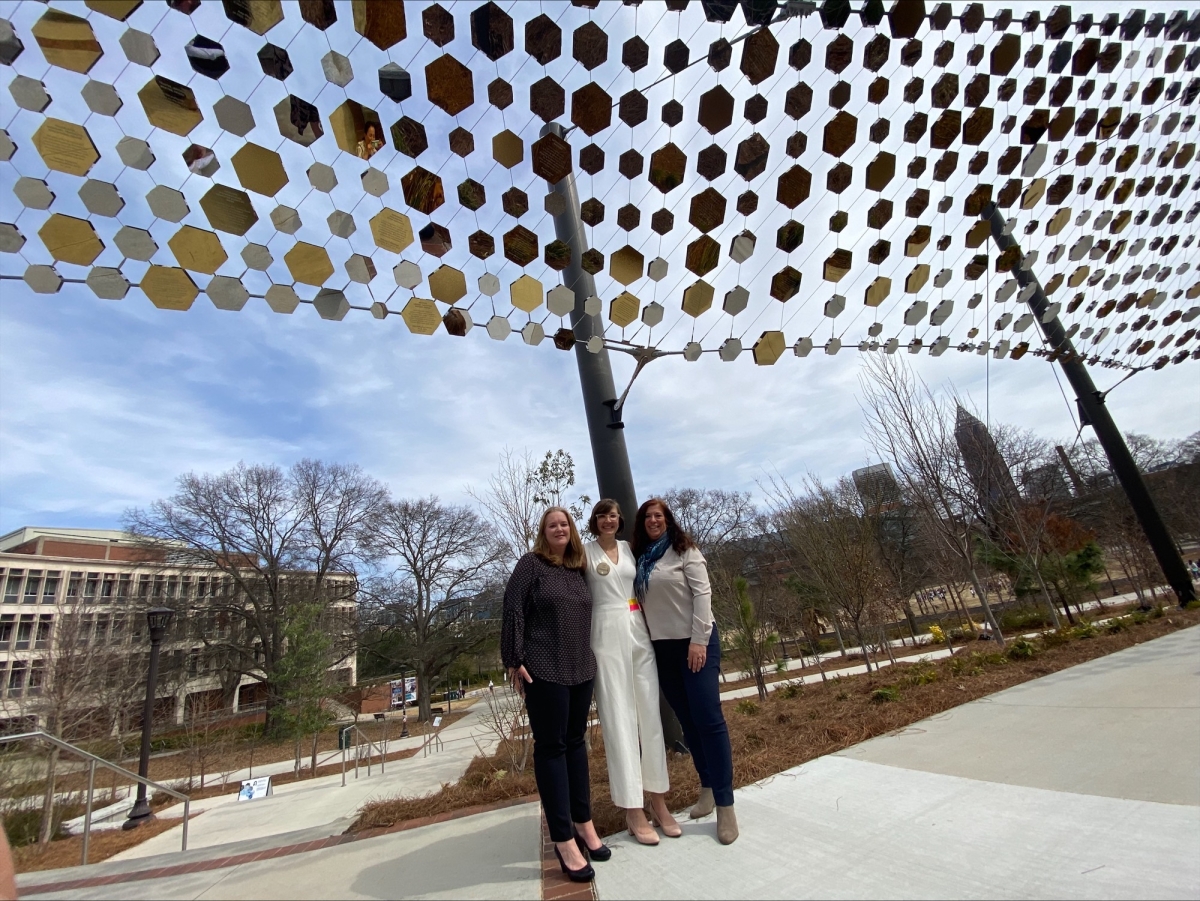
L to R: Holly Jeffreys, Malory Atkinson, and Karen Jenkins stand beneath the reflective hexagon tiles of the Pathway of Progress art installation at Georgia Tech.
Civil engineering alumnae were integral to the process of bringing Georgia Tech’s newest art installation to life.
The installation, called Pathway of Progress: Celebrating Georgia Tech Women, was officially opened on March 8. The structure contains nearly 3,000 mirrored tiles, each of which will one day tell the story of Tech alumnae, students, faculty, and staff who made a lasting impact.
The structural engineering for the project was provided by Shear Structural, a firm co-founded by three Georgia Tech alumnae: Malory Atkinson, BC 08, Holly Jeffreys, CE 96, and Karen Jenkins, M Arch 92, MS CE 93.
The women of Shear Structural are deeply intertwined with the project and actively engaged with their alma mater.
Shear Structural supports CEE through the Corporate Affiliates Program and provides a fellowship for master’s students in structural engineering. Jenkins serves as the chair of the School of Civil and Environmental Engineering’s External Advisory Board and Atkinson is one of the first honorees to be featured in the installation.
Atkinson, Jenkins, and Jeffries shared their experience working with Shear Structural as the Engineer of Record for the project.
“We love when engineering and art intersect, and this project is a perfect example of that synergy. It’s not every day that structural engineers get to work on something so visually striking and historically significant. We hope that the Pathway of Progress will inspire future generations of Georgia Tech students—especially women—to continue breaking barriers,” they said.
Q: All three of you are Georgia Tech alumnae. What was it like working on a project that honors the contributions of women at Georgia Tech?
A: This project felt personal to us. As Georgia Tech alumnae, we deeply appreciate the progress made by the women who paved the way before us. To contribute our expertise to a project that celebrates those trailblazers was an honor. It also reinforced why representation matters—seeing a women-led engineering firm play a role in this installation is a testament to the evolving landscape of STEM fields.
Q: How did you work with the architect and others to make this project a reality?
A: Collaboration was key. We worked closely with the architect to understand the artistic intent and then translated that vision into a feasible structural design. We also coordinated with fabricators and contractors to ensure constructability and efficiency, making adjustments along the way as needed. Open communication and teamwork were critical in turning this concept into a standing, lasting piece of art.
Q: Can you explain what Shear Structural did as the Engineer of Record?
A: As the Engineer of Record, Shear Structural was responsible for ensuring the structural integrity of the Pathway of Progress art installation. This means we designed and verified that the structure could safely support itself and withstand environmental forces like wind and gravity. We worked closely with the architect, fabricators, and contractors to translate the artistic vision into a buildable, durable, and code-compliant reality.
Q: What were some of the biggest challenges or unexpected aspects of this project?
A: Art installations often push structural boundaries, and this project was no exception. One of the biggest challenges was balancing the delicate, expressive nature of the artwork with the need for durability and safety. We also had to coordinate closely with the tight existing campus elements and the contractor to ensure the structural supports were seamlessly integrated without detracting from the visual or physical impact.
Q: What did you enjoy most about this project?
A: One of the most rewarding aspects of this project was the opportunity to bring an artistic vision to life in a way that is both structurally sound and visually compelling. We loved the challenge of engineering something that isn’t just functional but deeply meaningful. Plus, working on a project that honors women at Georgia Tech made it even more special, as we are a women-led structural firm with three Georgia Tech alumnae at the helm.
